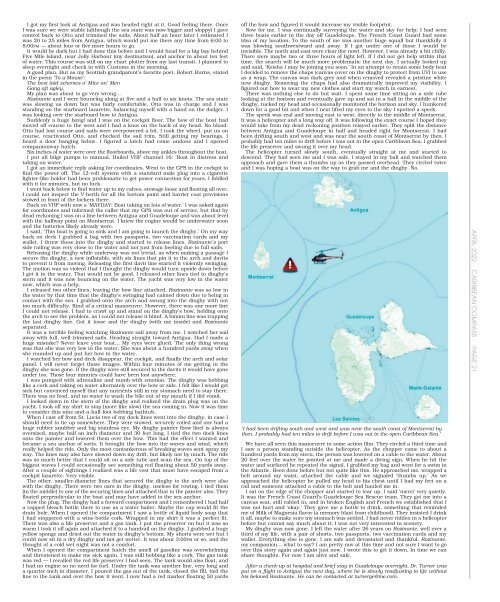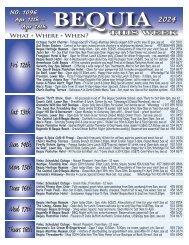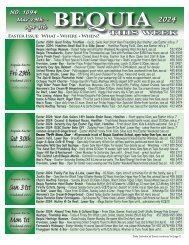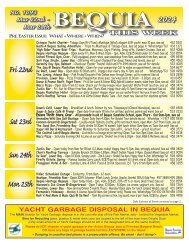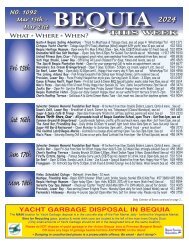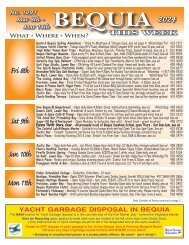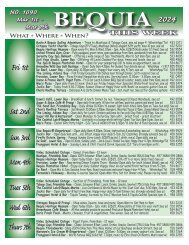Caribbean Compass Yachting Magazine - April 2022
Welcome to Caribbean Compass, the most widely-read boating publication in the Caribbean! THE MOST NEWS YOU CAN USE - feature articles on cruising destinations, regattas, environment, events...
Welcome to Caribbean Compass, the most widely-read boating publication in the Caribbean! THE MOST NEWS YOU CAN USE - feature articles on cruising destinations, regattas, environment, events...
You also want an ePaper? Increase the reach of your titles
YUMPU automatically turns print PDFs into web optimized ePapers that Google loves.
I got my first look at Antigua and was headed right at it. Good feeling there. Once<br />
I was sure we were stable (although the sea state was now bigger and sloppy) I gave<br />
control back to Otto and trimmed the sails. About half an hour later I estimated I<br />
was 20 to 25 miles from Antigua, which would put me there any time from 6:00 to<br />
8:00pm — about four or five more hours to go.<br />
It would be dark but I had done this before and I would head for a big bay behind<br />
Five Mile Island, near Jolly Harbour (my destination), and anchor in about ten feet<br />
of water. This course was still on my chart plotter from my last transit. I planned to<br />
sleep overnight and check in with Customs in the morning.<br />
A good plan. But as my Scottish grandparent’s favorite poet, Robert Burns, stated<br />
in the poem ‘To a Mouse’:<br />
The best laid schemes o’ Mice an’ Men<br />
Gang aft agley.<br />
My plan was about to go very wrong…<br />
Rozinante and I were bouncing along at five and a half to six knots. The sea state<br />
was slowing us down but was fairly comfortable. Otto was in charge and I was<br />
standing on the starboard lazarette, balancing myself with a hand on the dodger. I<br />
was looking over the starboard bow to Antigua.<br />
Suddenly a huge bang! and I was on the cockpit floor. The bow of the boat had<br />
moved off course to the west and I had a knot on the back of my head. No blood.<br />
Otto had lost course and sails were overpowered a bit. I took the wheel, put us on<br />
course, reactivated Otto, and checked the sail trim. Still getting my bearings, I<br />
heard a door banging below. I figured a latch had come undone and I opened<br />
companionway hatch.<br />
Six inches of water were over the floorboards, above my ankles throughout the boat.<br />
I put all bilge pumps to manual. Hailed VHF channel 16: ‘Boat in distress and<br />
taking on water.’<br />
I got an immediate reply asking for coordinates. Went to the GPS in the cockpit to<br />
find the power off. The 12-volt system with a standard male plug into a cigarette<br />
lighter-like holder had been problematic to get power connection for years. I fiddled<br />
with it for minutes, but no luck.<br />
I went back below to find water up to my calves, stowage loose and floating all over.<br />
I could not inspect the V-berth for all the bottom paint and barrier coat provisions<br />
stowed in front of the lockers there.<br />
Back on VHF with now a ‘MAYDAY: Boat taking on lots of water.’ I was asked again<br />
for coordinates and informed the caller that my GPS was out of service, but that by<br />
dead reckoning I was on a line between Antigua and Guadeloupe and was about level<br />
with the halfway point on Montserrat. I knew the engine would be underwater soon<br />
and the batteries likely already were.<br />
I said, ‘This boat is going to sink and I am going to launch the dinghy.’ On my way<br />
back on deck I grabbed a bag with two passports, two vaccination cards and my<br />
wallet. I threw these into the dinghy and started to release lines. Rozinante’s port<br />
side railing was very close to the water and not just from heeling due to full sails.<br />
Releasing the dinghy while underway was not trivial, as when making a passage I<br />
secure the dinghy, a new inflatable, with six lines that pin it to the arch and davits<br />
to prevent it from moving. Releasing the first davit line started it violently swinging.<br />
The motion was so violent that I thought the dinghy would turn upside down before<br />
I got it in the water. That would not be good. I released other lines tied to dinghy’s<br />
stern and it was now bouncing on the water. The yacht was very low in the water<br />
now, which was a help.<br />
I released two other lines, leaving the bow line attached. Rozinante was so low in<br />
the water by that time that the dinghy’s swinging had calmed down due to being in<br />
contact with the sea. I grabbed onto the arch and swung into the dinghy with not<br />
too much difficulty. Kind of a critical manoeuvre. However, there was one more line<br />
I could not release. I had to crawl up and stand on the dinghy’s bow, holding onto<br />
the arch to see the problem, as I could not release it blind. A bimini line was trapping<br />
the last dinghy line. Got it loose and the dinghy (with me inside) and Rozinante<br />
separated.<br />
It was a terrible feeling watching Rozinante sail away from me. I watched her sail<br />
away with full, well-trimmed sails. Heading straight toward Antigua. Had I made a<br />
huge mistake? Never leave your boat… My eyes were glued. The only thing wrong<br />
was that she was very low in the water. She was about a hundred yards away when<br />
she rounded up and put her bow in the water.<br />
I watched her bow and deck disappear, the cockpit, and finally the arch and solar<br />
panel. I will never forget those images. Within four minutes of me getting in the<br />
dinghy she was gone. If the dinghy were still secured to the davits it would have gone<br />
under too. Those four minutes could have been lost anywhere.<br />
I was pumped with adrenaline and numb with emotion. The dinghy was bobbing<br />
like a cork and taking on water alternately over the bow or side. I felt like I would get<br />
sick but convinced myself that any nutrients still in my stomach need to stay there.<br />
There was no food, and no water to wash the bile out of my mouth if I did vomit.<br />
I looked down in the stern of the dinghy and realized the drain plug was on the<br />
yacht. I took off my shirt to stop (more like slow) the sea coming in. Now it was time<br />
to consider this nine-and-a-half-foot bobbing bathtub.<br />
When I cast off from St. Lucia two of my dock lines went into the dinghy, in case I<br />
should need to tie up somewhere. They were stowed, securely coiled and one had a<br />
huge rubber snubber and big stainless eye. My dinghy painter (bow line) is always<br />
oversized, maybe half an inch diameter and 30 feet long. I tied the two dock lines<br />
onto the painter and lowered them over the bow. This had the effect I wanted and<br />
became a sea anchor of sorts. It brought the bow into the waves and wind, which<br />
really helped the ride. Only the most cantankerous of breaking waves sent spray my<br />
way. The lines may also have slowed down my drift, but likely not by much. The ride<br />
was so much better that I could sit on a side tube and scan the sea. On top of the<br />
biggest waves I could occasionally see something red floating about 50 yards away.<br />
After a couple of sightings I realized was a life vest that must have escaped from a<br />
cockpit lazarette. Very visible.<br />
The other, smaller-diameter lines that secured the dinghy to the arch were also<br />
with the dinghy. There were two oars in the dinghy, useless for rowing. I tied them<br />
(in the middle) to one of the securing lines and attached that to the painter also. They<br />
floated perpendicular to the boat and may have added to the sea anchor.<br />
Now the plug. The dinghy had a forward compartment and I remembered I had half<br />
a capped bleach bottle there to use as a water bailer. Maybe the cap would fit the<br />
drain hole. When I opened the compartment I saw a bottle of liquid body soap that<br />
I had stoppered with a wine-bottle cork. Wrapped in my shirt it was a perfect fit.<br />
There was also a life preserver and a gas tank. I put the preserver on but it was so<br />
warm I took it off again and attached it to a handrail on the dinghy. I grabbed a huge<br />
yellow sponge and dried out the water in dinghy’s bottom. My shorts were wet but I<br />
could now sit in a dry dinghy and not get wetter. It was about 3:00pm or so, and the<br />
thought of a cold wet night was not a comfort.<br />
When I opened the compartment hatch the smell of gasoline was overwhelming<br />
and threatened to make me sick again. I was still bobbing like a cork. The gas tank<br />
was red — I recalled the red life preserver I had seen. The tank would also float, and<br />
I had no engine so no need for fuel. Under the tank was another line, very long and<br />
a quarter-inch in diameter. I poured the gas out of the tank, closed the fill, tied the<br />
line to the tank and over the bow it went. I now had a red marker floating 50 yards<br />
off the bow and figured it would increase my visible footprint.<br />
Now for me. I was continually surveying the water and sky for help; I had seen<br />
three boats earlier in the day off Guadeloupe. The French Coast Guard had some<br />
idea of my location. To the south of me was another huge squall but thankfully it<br />
was blowing southwestward and away. If I got under one of those I would be<br />
invisible. The north and east were clear (for now). However, I was already a bit chilly.<br />
There were maybe two or three hours of light left. If I did not get help within that<br />
time, the search will be much more problematic the next day. I actually looked up<br />
and said, ‘Keisha I may be joining you soon.’ In an attempt to retain some body heat<br />
I decided to remove the chaps (canvas cover on the dinghy to protect from UV) to use<br />
as a wrap. The canvas was dark grey and when removed revealed a pristine white<br />
new dinghy. Removing the chaps had also dramatically improved my visibility. I<br />
figured out how to wear my new clothes and start my watch in earnest.<br />
There was nothing else to do but wait. I spent some time sitting on a side tube<br />
looking at the horizon and eventually gave up and sat in a ball in the middle of the<br />
dinghy, tucked my head and occasionally monitored the horizon and sky. I hunkered<br />
down for a good bit and when I next lifted my eyes to the sky I spotted a speck.<br />
The speck was real and moving east to west, directly to the middle of Montserrat.<br />
It was a helicopter and a long way off. It was following the exact course I hoped they<br />
would take from my dead reckoning position relayed earlier. They split the distance<br />
between Antigua and Guadeloupe in half and headed right for Montserrat. I had<br />
been drifting south and west and was near the south coast of Montserrat by then. I<br />
probably had ten miles to drift before I was out in the open <strong>Caribbean</strong> Sea. I grabbed<br />
the life preserver and swung it over my head.<br />
The helicopter turned slowly south, eventually straight at me and started to<br />
descend. They had seen me and I was safe. I stayed in my ball and watched them<br />
approach and gave them a thumbs up as they passed overhead. They circled twice<br />
and I was hoping a boat was on the way to grab me and the dinghy. No.<br />
‘I had been drifting south and west and was near the south coast of Montserrat by<br />
then. I probably had ten miles to drift before I was out in the open <strong>Caribbean</strong> Sea.’<br />
We have all seen this manoeuvre in some action film. They circled a third time and<br />
I saw a person standing outside the helicopter. As the chopper came to about a<br />
hundred yards from my stern, the person was lowered on a cable to the water. About<br />
20 feet over the water he pointed at me and made a diving sign. When he hit the<br />
water and surfaced he repeated the signal. I grabbed my bag and went for a swim in<br />
the Atlantic. Been done before but not quite like this. He approached me, wrapped a<br />
belt around my waist, attached the cable and we signaled ‘thumbs up.’ As we<br />
approached the helicopter he pulled my head to his chest until I had my feet on a<br />
rail and someone attached a cable to the belt and hauled me in.<br />
I sat on the edge of the chopper and started to tear up. I said ‘merci’ very quietly.<br />
It was the French Coast Guard’s Guadeloupe Sea Rescue team. They got me into a<br />
canvas seat, still cabled in, and in broken English and French we established that I<br />
was not hurt and ‘okay.’ They gave me a bottle to drink, something that reminded<br />
me of Milk of Magnesia flavor (a memory blast from childhood). They insisted I drink<br />
it all, maybe to make sure my stomach was settled. I had never ridden in a helicopter<br />
before but cannot say much about it; I was not very interested in scenery.<br />
My dinghy was now gone. I left the water after 26 years on Rozinante, well over a<br />
third of my life, with a pair of shorts, two passports, two vaccination cards and my<br />
wallet. Everything else is gone. I am safe and devastated and thankful. Rozinante,<br />
my companion... what to say? I am pretty raw at this time and not sure I want to go<br />
over this story again and again just now. I wrote this to get it down. In time we can<br />
share thoughts. For now I am alive and safe.<br />
After a check-up at hospital and brief stay in Guadeloupe overnight, Dr. Turner was<br />
put on a flight to Antigua the next day, where he is slowly readjusting to life without<br />
his beloved Rozinante. He can be contacted at turnerge@me.com.<br />
APRIL <strong>2022</strong> CARIBBEAN COMPASS PAGE 21


